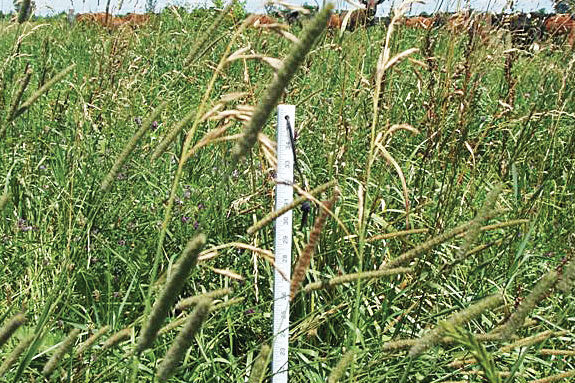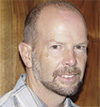I’m not sure I really like the term “mob” grazing because it makes you think that you will pulverize the site, and in some cases I think that is what has happened.
The main idea in “mobbing” should be to address carbon and nutrient recycling by slowly building the percentage of organic matter in the soil and increasing availability of nutrients from increased microflora, increased root mass, concentrated, yet more uniform manure and urine distribution, and increased infiltration through grazing density and duration management.
In a high-density, short-duration grazing system, livestock entering heights should probably be a minimum of 15 inches for cool-season forages and 30 inches for warm-season forages – but this will vary according to site conditions and forages.
Some forage should be at least in the milk stage of seed production prior to grazing. Entering heights may appear shorter than they really are after seedhead maturity or due to the lack of seedhead production in some cases.
Grass plants that are not stressed produce less seed. As the soil health improves, water and mineral cycling improves too and you have more energy storage.
Stocking density relates to the number of animals or total pounds of live weight on a given amount of ground at any one point in time.
This is different than stocking rate, which is the number of animals or pounds of live weight per unit of ground for a set period of time.

We use the prior, stocking density, when applying this practice. The amount of density or pounds per acre of live animals for a set duration will vary according to the results or impact desired.
Lower densities, 40,000 to 200,000 pounds of live weight per acre, are better for high-moisture conditions and when grazing periods greater than 24 hours are needed (but never over 48 hours).
Higher densities, 200,000 to 500,000 pounds of live weight per acre, leave a larger footprint, but also create the higher impact desired to recycle nutrients.
Higher density requires four-hour to 24-hour moves to new allotments. Start with the same stocking rate – just increase stock density. If you don’t have enough available forage, sometimes reducing stock initially is warranted.
During the growing season, it is critical that back fencing be utilized so animals do not start grazing regrowth when possible – otherwise limit to four to five days. It is not as critical during the dormant season as long as the soil is firm enough to not degrade the forage resource.
By concentrating the livestock in such a manner, the animals eat the higher-quality forages present and tread some of the remaining forages and plant material into or onto the soil surface.
It is very important to monitor this and ensure the soil is continuously covered and forages are not excessively damaged. After being grazed in this manner, the forage should be deferred from grazing until it has totally restored itself to the same growth stage or longer.
Concentrating the livestock in such a manner also concentrates manure and urine, but it also does a better job of distribution of those products. The higher the density and the shorter the duration, the more often or quicker the animals will need to be moved.
This is, of course, highly influenced by the amount of dry matter actually available to be grazed. Thick, very heavy forage can be grazed at a higher density and or slightly longer time period than thinner stands – but always manage for animal performance.
Depending on the impact, deferment may be needed for longer-than-normal periods and up to one year in some cases.
By allowing the forages to mature more, we allow them to develop extensive, deep root systems which help to bring up nutrients from lower in the profile, slowly build organic matter from decaying roots as the tops are removed and excite the micro-flora in the soil (bacteria, fungi and macros) that utilize the biosphere of the plant root very efficiently and recycle and produce additional nitrogen and other nutrients.
Soil conditions, soil types, forage types and densities not only vary a lot from farm to farm, they also quite often vary in the same field. Livestock density and grazing period may often need to be adjusted to meet the present conditions or the nutritional needs of the livestock grazing it.
The nutritional needs of the grazing livestock should never be jeopardized. Swards need to be adequate in both crude protein and energy to meet the needs of the grazing livestock. Solid grass swards are very common, and are often more adequate for non-lactating and non-growing animals due to lower energy than for growing or lactating animals.
Swards with sufficient high-sugar or high-energy grass and legumes may meet needs of lactating or growing animals, but all should be tested. Usually cool-season grass legume mixtures need to have a minimum of 40 percent dry matter in legumes before meeting energy requirements.
This is subject to the type and variety of forages being grown. It is up to the grazier to adjust allocations as forage conditions and animal requirements change.
Water and mineral should be available to grazing livestock at all times. Adequate water can often be supplied with a small portable tank by movable pipe or hose from a hydrant or quick coupler due to a very short walking distance.
The watering system needs to be easily movable to be able to advance along with the grazing livestock as they are moved.
Long linear-type permanent fencing lends itself the most ideal way to be ready to set up allocations without needing to put up excessively long sections of temporary fence.
The closer the linear fences are together, the shorter the temporary fence runs, but potentially wider spans as you progress down the grazing allotment. Generally, a minimum of three sets of portable fence sets are needed.
One set consisting of a reel with good-quality poly-wire or braided wire, a good handle on the end and adequate number of step-in poly posts. The first set will be the lead fence in front of the animals’ allotment.
The second fence is a back fence to keep them from going back where they just grazed. The third set is for the next allocation, ready for the next move. The back fence moves all the way forward to the front after the livestock are moved to the newest allotment and repeated thereafter until that portion of the field is grazed.
High-density short-duration grazing is a tool for the grazing toolbox. Though advocated as a year-round system and possible, I suppose, it might be best utilized as a part-time means to improve soil health or an improved way of utilizing more mature forages. FG
PHOTOS
TOP RIGHT: A pasture, shown before high-density, short-duration grazing.
BOTTOM RIGHT: A pasture, shown after high-density, short-duration grazing. This practice can build the percentage of organic matter in the soil and increase availability of nutrients from increased root mass and more uniform manure distribution. Photos courtesy of Victor Shelton.









